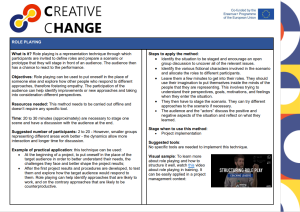Role Playing
What is it? Role playing is a representation technique through which participants are invited to define roles and prepare a scenario or prototype that they will stage in front of an audience. The audience then has a chance to react to the performance.
Objectives: Role playing can be used to put oneself in the place of someone else and explore how other people who respond to different approaches, therefore fostering empathy. The participation of the audience can help identify improvements or new approaches and taking into consideration different perspectives.
Resources needed: This method needs to be carried out offline and doesn’t require any specific tool.
Time: 20 to 30 minutes (approximately) are necessary to stage one scene and have a discussion with the audience at the end.
Suggested number of participants: 2 to 20 – However, smaller groups representing different areas work better – the dynamics allow more interaction and longer time for discussion.
Example of practical application: this technique can be used:
- At the beginning of a project, to put oneself in the place of the target audience in order to better understand their needs, the challenges they face and better shape the project results;
- After the first project results and procedures are developed, to test them and explore how the target audience would respond to them. Role playing can help identify approaches that are likely to work, and on the contrary approaches that are likely to be counterproductive.
Steps to apply the method:
- Identify the situation to be staged and encourage an open group discussion to uncover all of the relevant issues.
- Identify the various fictional characters involved in the scenario and allocate the roles to different participants.
- Leave them a few minutes to get into their roles. They should use their imagination to put themselves inside the minds of the people that they are representing. This involves trying to understand their perspectives, goals, motivations, and feelings when they enter the situation.
- They then have to stage the scenario. They can try different approaches to the scenario if necessary.
- The audience and the “actors” discuss the positive and negative aspects of the situation and reflect on what they learned.
Stage when to use this method:
- Project implementation
Suggested tools:
No specific tools are needed to implement this technique.
Visual sample: To learn more about role playing and how to structure it well, watch this video about role playing in training. It can be easily applied in a project management context.


